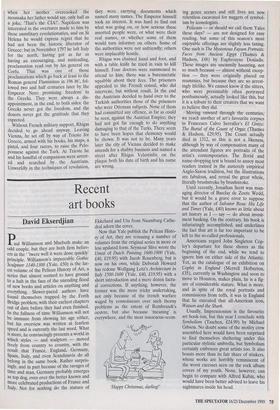Recent art books
David Ekserdjian
Paul Williamson and Macbeth make an odd couple, but they are both firm believ- ers in the "twere well it were done quickly' principle. Williamson's impeccable Gothic Sculpture 1140-1300 (Yale, £50) is the lat- est volume of the Pelican History of Art, a series that almost seemed to have ground to a halt in the face of the unending flood of new books and articles on anything and everything. Slower-paced authors have found themselves trapped by the Forth Bridge problem, with their earliest chapters out of date before they had even finished. In the fullness of time Williamson will not be immune from showing his age either, but his overview was written at fearless speed and is currently the last word. What is more, he convincingly presents a world in which styles -- and sculptors — moved freely from country to country, with the result that France, England, Germany, Spain, Italy, and even Scandinavia do all belong in the same book. Rather surpris- ingly, and in part because of the ravages of time and man, Germany probably emerges as top dog, even over the better known and more celebrated productions of France and Italy. Not for nothing do the statues of Ekkehard and Uta from Naumburg Cathe- dral adorn the cover.
Now that Yale publish the Pelican Histo- ry of Art, they are reissuing a number of volumes from the original series in more or less updated form. Seymour Slive wrote the Urtext of Dutch Painting 1600-1800 (Yale, £40, £19.95) with Jacob Rosenberg, but is now on his own, while Deborah Howard has redone Wolfgang Lotz's Architecture in Italy 1500-1600 (Yale, £40, £19.95) with a short introduction and a mere dozen factu- al corrections. If anything, however, the former was the more tricky undertaking, not only because of the trench warfare waged by connoisseurs over such thorny problems as the extent of Rembrandt's oeuvre, but also because 'meaning' is everywhere, and the most innocuous-seem- `Happy Christmas, darling!' ing genre scenes and still lives are now relentless excavated for nuggets of symbol- ism by iconologists.
Pelicans — or should we call them Yales these days? — are not designed for easy reading, but some of this season's most enjoyable offerings are slightly less taxing. One such is The Mysterious Fayum Portraits: Faces from Ancient Egypt (Thames & Hudson, £48) by Euphrosyne Doxiadis. These images are uncannily haunting, not so much because — almost without excep- tion — they were originally placed on mummies, but because they are so arrest- ingly lifelike. We cannot know if the sitters, who were presumably often portrayed posthumously, actually looked like this, but it is a tribute to their creators that we want to believe they did.
Moving onward through the centuries, we reach another of art's favourite corpses in Francesco Calvo Serraller's El Greco: The Burial of the Count of Orgaz (Thames & Hudson, £29.95). The Count actually died in 1312, so this is not a likeness, although by way of compensation many of the attendant figures are portraits of the artist's contemporaries. The florid and name-dropping text is bound to annoy most readers trained in the austerely empirical Anglo-Saxon tradition, but the illustrations are fabulous, and reveal the great whole, literally brushstroke by brushstroke.
Until recently, Jonathan Scott was man- aging director of Barclay de Zoete Wedd, but it would be a grave error to suppose that the author of Salvator Rosa: His Life and Times (Yale, £40) knows as little about art history as I — say — do about invest- ment banking. On the contrary, his book is infuriatingly accomplished, and underlines the fact that art is far too important to be left to the so-called professionals.
Americans regard John Singleton Cop- ley's departure for these shores as the beginning of the end, while we tend to ignore him on either side of the Atlantic. Yet, as the catalogue of an exhibition on Copley in England (Merrell Holberton, £35), currently in Washington and soon to move to Houston, makes plain, he is a fig- ure of considerable stature. What is more, and in spite of the royal portraits and commissions from toffs, it was in England that he executed that all-American icon, Watson and the Shark.
Usually, Impressionism is the favourite art book-ism, but this year I conclude with Symbolism (Taschen, £24.99) by Michael Gibson. No doubt some of the motley crew assembled here would have been surprised to find themselves sheltering under this particular stylistic umbrella, but Symbolism certainly embraces great artists too. It also boasts more than its fair share of stinkers, whose works are horribly reminiscent of the worst excesses seen on the rock album covers of my youth. None, however, can begin to compare with Alfred Kubin, who would have been better advised to leave his nightmares inside his head.










































































































 Previous page
Previous page